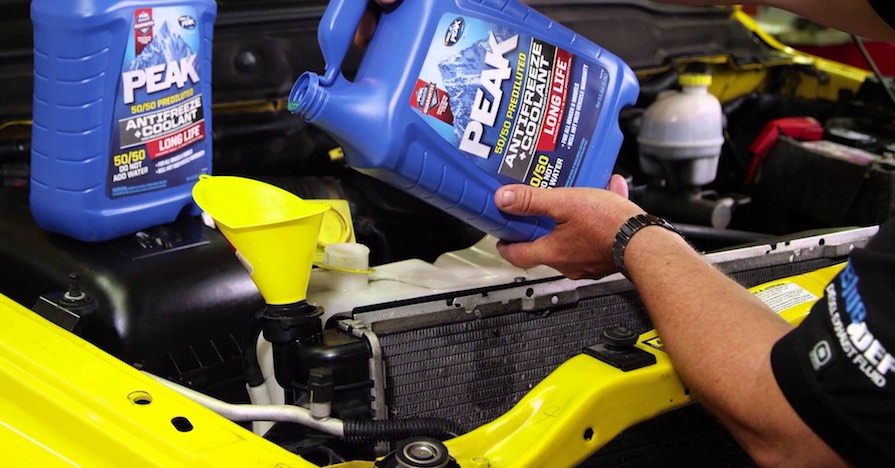The Connection Between Coolant and Water Pump Failure

Water pump failure can put a real damper on your day. If you’ve just discovered a pool of coolant underneath your car or noticed it running hot, you might be wondering what happened? Diagnosing the problem can be as easy as testing your coolant and checking the levels in the reservoir.
What causes water pump failure?
 Water pump failure can stem from the condition and amount of coolant in your vehicle’s cooling system. Your vehicle’s engine is working extremely hard, and in turn, generating lots of heat. To prevent it from overheating, the water pump circulates coolant throughout the engine and cooling system to remove heat from critical engine parts. This helps the engine, engine oil, and transmission fluid operate at optimal temperatures.
Water pump failure can stem from the condition and amount of coolant in your vehicle’s cooling system. Your vehicle’s engine is working extremely hard, and in turn, generating lots of heat. To prevent it from overheating, the water pump circulates coolant throughout the engine and cooling system to remove heat from critical engine parts. This helps the engine, engine oil, and transmission fluid operate at optimal temperatures.
When coolant condition is poor it cannot properly control engine temperatures, nor can it properly care for the water pump. If your engine temperature rises, things can get troublesome pretty quickly. At just 18-degrees above its normal temperature, the important inhibitors in the coolant that protect the water pump from cavitation, rust, scale, and sludge become less effective. As these degrade, failure of your water pump can occur.
Extremely low coolant can damage the water pump by allowing it to spin without the the protection provided by the coolant. Damage to the seals and bearings can then occur and even continue after the system has been refilled to the correct level. Never allow the engine to run with an empty cooling system under any circumstance. Better to park it and call a tow truck than risk destroying an engine.
Check and test coolant levels regularly
Have you checked your coolant levels lately? Each time you open the hood is an opportunity to monitor coolant levels and get a reading on your vehicle’s health. Remember, never check coolant levels when the engine is hot. Wait until the engine has cooled and the system has depressurized before opening the radiator cap or pressurized overflow tank. If the level is low, you can refill quickly using widely compatible premixed coolant like PEAK Long-Life 50/50.
Testing your coolant can be done using a handheld antifreeze tester. This handy tool allows you to measure the freezing point of your coolant and adjust the water to coolant ratio accordingly. We recommend using distilled water to dilute the coolant if the ratio is too high. To increase the coolant ratio, use a full strength coolant like PEAK Long-Life Full Strength.
Revive your cooling system
 If the coolant is dirty or the test indicates poor quality, we suggest performing a complete flush of the system and refill with PEAK Long-Life Full Strength and distilled water mixture. Performing a complete cooling system flush removes worn out and dirty coolant, replenishing the additives that protect the water pump. Flushing a cooling system is a messy project, so be prepared to catch the old fluid for recycling, as well as to clean up any spills. You may prefer to visit to your trusted local repair shop if you aren’t comfortable doing this project yourself. They will also be able to recycle your old coolant correctly, saving you the hassle.
If the coolant is dirty or the test indicates poor quality, we suggest performing a complete flush of the system and refill with PEAK Long-Life Full Strength and distilled water mixture. Performing a complete cooling system flush removes worn out and dirty coolant, replenishing the additives that protect the water pump. Flushing a cooling system is a messy project, so be prepared to catch the old fluid for recycling, as well as to clean up any spills. You may prefer to visit to your trusted local repair shop if you aren’t comfortable doing this project yourself. They will also be able to recycle your old coolant correctly, saving you the hassle.
Maintaining your coolant can help prolong the life of your water pump. Coolant is easy to take for granted, but it is also simple to check. Make coolant checks part of your regular vehicle maintenance schedule.
Check out all the chemical & lubricant products available on NAPA Online or trust one of our 16,000 NAPA AutoCare locations for routine maintenance and repairs. For more information on water pump failure, chat with a knowledgeable expert at your local NAPA AUTO PARTS store.
